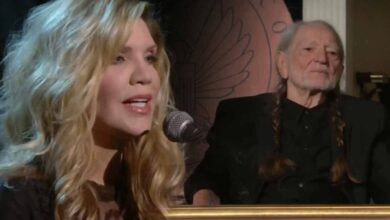Randy Travis’ Brother Delivered a Heartfelt Tribute With “Deeper Than The Holler”
“Deeper Than the Holler” exemplifies the storytelling essence of classic country music, which often revolves around emotional sincerity and relatable experiences. The year 1988 marked an important milestone in Randy Travis’ career with this particular track, as it became one of the standout songs on his album “Always & Forever.” Dealing with themes that resonate on a personal level, the song showcases the ability of country music to articulate complex emotions through straightforward narratives. The collaboration between songwriters Paul Overstreet and Don Schlitz has yielded a piece that continues to speak to listeners, emphasizing the importance of thoughtful lyricism in crafting memorable songs.
The imagery woven throughout “Deeper Than the Holler” provides a vivid backdrop that enhances the emotional weight of the lyrics. The use of “holler” not only invokes a specific geographical context but also symbolizes a deeper emotional connection the narrator feels towards his loved one. The contrast between the vastness of nature and the intimate feelings of love presents a powerful picture of dedication. Lines in the chorus, such as “I can see the stars falling one by one,” reflect a sense of wonder and awe, suggesting that the narrator perceives his love as both limitless and eternal. Such metaphors invite listeners to visualize the depth of the narrator’s affection in a tangible way, bridging the gap between the heart and the landscape around them.
Musically, the song is structured in a way that complements its lyrical themes. The arrangement primarily features traditional country instruments—acoustic guitar, fiddle, and steel guitar—which work together to create a sound that is both warm and engaging. The production emphasizes the organic quality of the performance, allowing Randy Travis’ rich baritone and emotive vocal delivery to take center stage. This deliberate musical choice helps to convey the sincerity of the message, inviting listeners to connect with the song on a personal level. The flow of the melody mirrors the undulating rhythms of love and longing, reinforcing the idea that heartfelt emotions often have a natural, almost rhythmic quality.
Randy Travis’ interpretation of the song has played a crucial role in its success. With his distinctive voice, he is able to imbue the lyrics with a sense of authenticity that resonates strongly with audiences. His performance on “Deeper Than the Holler” reflects an inner depth, drawing listeners into the narrative of the song. This natural connection is part of what has made Travis a pivotal figure in country music; he not only entertains but also connects with the shared human experiences that the genre often explores.
The song’s subsequent popularity is evident as artists from various generations have been inspired to cover it, adding new dimensions while respecting its original sentiment. Carrie Underwood, with her powerful range and emotional intensity, brings her own interpretations to the lyrics, allowing her version to stand alongside Travis’ iconic rendition. Similarly, Josh Turner adds a contemporary twist while honoring the foundational elements of the classic song. These varied interpretations speak to the song’s adaptability and the core themes of love and devotion that resonate universally.
In addition to its lyrical and musical strengths, “Deeper Than the Holler” reflects an era in country music characterized by a return to its traditional roots. As the industry evolved through the late 1980s and into the 1990s, artists like Travis were pivotal in bridging the gap between classic country and the emerging sounds of contemporary country music. His work has contributed to a resurgence in storytelling within the genre, inspiring a new generation of musicians to embrace the heart of country music narratives.
Randy Travis, born Randy Traywick, is often regarded as a pioneer of neotraditional country music. Over his extensive career, he garnered numerous awards and accolades, including multiple Grammy Awards, Academy of Country Music Awards, and Country Music Association Awards. He is celebrated not just for his musical talents but also for his ability to convey the emotional nuances of the human experience through song. His journey from humble beginnings in North Carolina to becoming a staple in country music showcases his dedication and enduring legacy within the genre.
The legacy of “Deeper Than the Holler” is indicative of the broader narrative threads that connect various songs within the country music canon. It serves as a reminder that at its core, country music is a genre that champions heartfelt storytelling, often revolving around love, loss, and redemption. The song has transcended time, continuing to resonate with audiences new and old, a testament to both the skill of its creators and the power of its message.
In a landscape where music trends come and go, the timeless nature of “Deeper Than the Holler” demonstrates the lasting power of genuine emotion expressed through art. It stands as a classic example of the type of storytelling that resonates across generations, celebrating the nuances of love and commitment that define human relationships. As listeners continue to find solace and connection through its melodies and lyrics, the song firmly maintains its status as a cornerstone of country music, ensuring that its relevance will endure for years to come.





